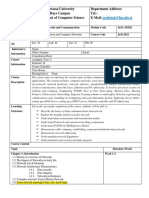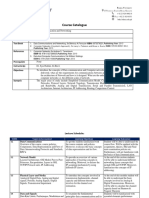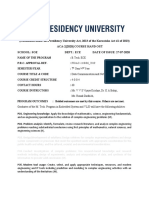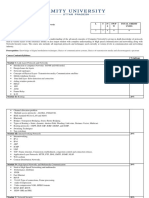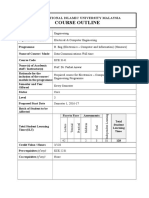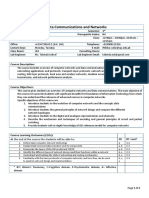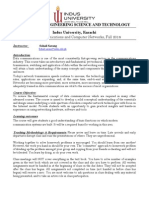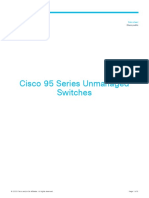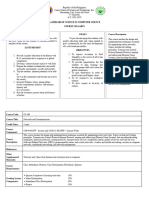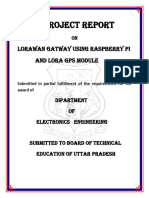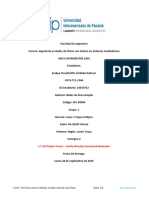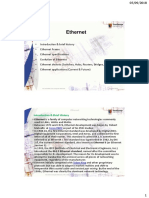Ethiopian Defence University, College of Engineering
Department of Computer Science and Engineering
Course Syllabus
1. Course Information
Course Name Data Communication and Computer networks
Course Code ECNG 2312
Credit hours C Le La T
3 2 3 0
Pre-requisite
Course Status Major/Core
2. Instructor Information
Name Fisseha Weldeanenia
Office Location EDU Innovation department Office number A20
Phone Number +251913386328
E-mail rigb2027@gmail.com
Consultation / Office Hours
3. Technical Assistant Contact Information
Name / Phone Number 1.Eyerusalem
2.Mahder Teshome
E-mail
4. Course Description
Aim: The aim of this course is to achieve knowledge in data encoding techniques, Network design,
configure and understand protocols.
Description
Communication Fundamentals: Data Transmission, Transmission Media, Data Encoding, Data Communication
Interface; Data link layer: Framing, Error Detection and Error Control, Reliable Transmission, IEEE Standards:
Ethernet, Token Ring, FDDI, Token Bus, Wireless LAN , Bridges and LANS switches, Network architecture,
Layering and protocols, OSI Architecture, TCP/IP Architecture , Multiplexing; Switching :Circuit switching,
Packet switching; Internetworking :IP Addressing, Sub netting, Classless Inter domain Routing , Routing ,
Routing algorithms, Address Resolution Protocol, Reverse Address Resolution Protocol, Dynamic Host
Configuration Protocol, Internet Control Message Protocol, IPv6; Transport Layer: User Datagram Protocol
(UDP), Transmission Control Protocol, Queuing Disciplines, Congestion-Avoidance Mechanisms, Quality of
Service; Applications: Domain Name System (DNS), E mail, World Wide Web (HTTP), Simple Network
Management Protocol, File Transfer Protocol (FTP), Security, Multimedia applications
5. Method of Instruction
Lectures This course has 16 weeks of lectures.
Each week has 2 hours lecturing.
Every student need to attentively attend all the class and collect
all supporting material for each class session in advance.
Lecturer should prepare the chapter slides in advance and should
be distributed to the students beforehand.
Every student should maintain a notebook for the course and
1
� should be checked periodically.
In-class Tutorial
Study of lecture notes Detailed notes should be prepared on all the topics of the syllabus
and should be supplied as supporting material.
Lecture notes supplied should be properly read by the students in
time.
Lab manuals and e-books soft copy materials will be provided.
Demonstrations For each Lab session, sample experimental work/problem
solved/explained as a demonstration
Lab Assignments / Practice 3 hrs. Per week lectures will be delivered.
Ensuring that students know how the lab fits into the course
content
Lab works are conducted in individual bases.
Lab reports are to be submitted and collected within a week
duration.
Team Project / Mini- A group assignment has to be conducted by the students.
Project / Group A group should not contain more than 4 students.
Assignment All group assignment problems should be approved by the sections.
Group assignment problems should be submitted to the student in the
first four weeks of the semester.
Evaluation of the assignments should be conducted during the last week
of the semester.
Every assignment should be supported by a well written report.
Role of each group member should be clearly defined. Hence every
individual in the group should be evaluated systematically.
Quizzes/ Individual There will be 2 quizzes, one before Mid semester and the other
Assignments after mid semester a week before final exam.
6. Learning Outcomes
After the completion of the course the student will have the following attributes:
6.1 Knowledge
6.1. Knowledge:
1 Describe Fundamental concepts of data communication,
Describe the various types of data encoding techniques
Familiarize with congestion control & Quality of Service
6.1. Comprehension:
2 Understand the characteristics of analog and digital signals on the given parameter.
Understand the characteristics of transmission medias,
Understand the techniques used in Multiplexing and Switching.
6.1. Application:
3 Apply IP addressing and Subneting.
Apply different types of services given by application layer.
6.1. Analysis:
4 Analyze various modulation technique in analog and digital career system
Analyze error detection and control methods
2
� Recognize the basic networking devices and their applications
Analyze short range and long-range wireless technologies
6.1. Synthesis:
5 Synthesis the concept of properties of TCP/IP's various application layer protocols
6.1. Evaluation:
6 Evaluate the layers and their functions of the OSI reference model
Evaluate various types of Networks, Routing algorithm, Switching and framing
6.2 Practical skills
6.2. Perception:
1 Logical thinking to develop computer networks
6.2. Set:
2 Implement Network Installation and configuration
Implement the working principles of the Internetworking devices
Configure and test various networking devices
6.2. Guided Response:
3 Follow the steps to design and develop various network connections.
Follow the steps to test the connectivity & troubleshoot the problem in the network
6.2. Adaption:
4 Share printer and folder in a network and transfer a file from one computer to another.
6.3 Attitude and behavior
6.3. Receiving
1 Demonstrate active listening skills when learning about Data Transmission and Data
Encoding to accurately receive and understand technical information.
Show open-mindedness and willingness to learn when exploring a wide range of Data
Communication Interfaces and understanding their applications in networking.
6.3. Responding
2 Respond to network scaling challenges by demonstrating an understanding of IP
Addressing, Subnetting, and Classless Inter-Domain Routing, and proposing suitable
solutions.
Engage in collaborative discussions to understand the benefits and drawbacks of various
network architectures, like Bridges and LANs switches, and provide constructive responses
to design considerations
6.3. Valuing
3 Value the importance of quality of service (QoS) in networking and understand how it
impacts the user experience and network performance.
6.3. Organizing
4 Demonstrate meticulous planning skills by organizing the components and layers of the
OSI Architecture and TCP/IP Architecture in a structured manner for effective network
design.
Apply problem-solving skills to address issues related to Error Detection and Error Control
in data link layers, demonstrating a proactive approach to network troubleshooting.
6.3. Internalize
5 Internalize the key concepts of Circuit switching and Packet switching to make informed
decisions about network architectures and their suitability for specific applications.
3
� 7. Course Outline
Chapter Topics to be covered Learning Assignments/activity (Tutorial hours)
(Lecture Week Outcomes
hours)
4
� 1 Need of Computer 6.1.1
Chapter Network
6.1.2
Communications Model
1 Networks, Protocols and 6.2.1
Data Standards
Categories of Networks 6.3.1
Classify computer networks on the specified
Commu parameter.
and Internetworks
nication Network Topologies 6.3.2
Describe role of the given component in the
Fundam process of data communication.
entals
(2 Hrs.)
Reference Models: OSI, 6.1.6
Chapter TCP/IP
6.2.2
Need of Layers
2 Functions of each layer 6.2.3
Network 2 A Comparison of OSI
and TCP Reference 6.3.1
Protocol Lab 1 & 2
Model
s and
Architec
tures
(2 Hrs.)
Analog Signals: Sine 6.1.1
Chapter wave, Amplitude, Phase,
Time and Frequency 6.1.1
3 3 Digital Signal: Bit rate,
6.3.1 Lab 3
Data and Bit length
Signal transmission
Signals
Transmission
(2 Hrs.) Impairments
Properties of analog and 6.1.1
Chapter digital signals
6.1.4
4 Digital data transmission
4 over digital signal: NRZ
6.3.1
Data encoding
Digital data transmission Lab 4
Encodin over analog signal: ASK,
g and FSK, PSK, QAM
Analog data transmission
Transmi
over digital signal:
ssion Digitization, PCM, Delta
Modulation (DM)
5
� modes Analog data transmission
over analog signal: AM,
(2 Hrs.)
FM, PM
Transmission modes:
Parallel, Serial
transmissions
5 Guided media 6.1.2
Chapter Optical fiber
6.2.2
Wireless media
5
Serial & Parallel 6.2.3 Group assignment:
Transmi transmission Prepare a report on recent and widely used
Synchronous &
ssion unguided media in industries depending on
Asynchronous
Media Transmission Cost, speed, efficiency, reliability.
and Interfacing Lab 5
Modes
(2 Hrs.)
6 Methods of Switching 6.1.2
Chapter Circuit Switching
6.2.3
Packet Switching
6
Multiplexing: FDM, 6.3.1
Switchin WDM, TDM
g and Lab 6
Multiple
xing
(2 Hrs.)
Data Link Layer services 6.1.1
Chapter 7 Framing
6.1.4
Types of errors, Error
7 detection and Correction 6.1.6
Data Data Link Control and Lab 7
Protocols 6.2.3
Link
Flow and Error Control
layer 6.3.1
(4 Hrs.) 6.3.4
6
� Ethernet LAN: 6.1.4
8 Standards, Addressing,
Access Methods 6.1.2
Lab 8
IEEE 802.1Q VLAN
6.1.4
Wireless LAN
6.3.2
9 Mid Examination Period
Network layer services
Chapter 10 Packetizing
6.1.6
Packet Switching
8
Internetworking & 6.1.3
Network devices: Repeaters,
Hubs, Bridges, Switches, Lab 9 & 10
Layer: 6.2.2
Router, Gateway
(2 Hrs.) IP addresses & Subnets
Network Layer
Protocols:
IP, ARP, ICMP, IPV6
Routing and Forwarding 6.1.6
Chapter 11 & 12 Routing techniques:
6.1.5 HW1: Create a small Network install,
static, Dynamic routing
9 Routing algorithms configure various devices and perform at
6.2.2
Routing Unicast Routing least one peer-to-peer services and
Protocols: RIP, OSPF 6.3.1 client/server service over it.
(4 Hrs.)
BGP
6.3.5
Lab 11 & 12
13 Transport-Layer Services 6.1.6
Ports and sockets
6.1.5
Process to Process
delivery: TCP, UDP 6.1.1 Lab 13 & 14
Chapter Congestion Control:
Open Loop, Closed Loop 6.3.1
10
choke packets
Internet 6.3.4
14 Quality of service 6.1.4 Group assignment: Design layout of a
working
Techniques to improve Network for department, deciding upon type
(6 Hrs.) 6.3.1
QoS of network, number/length of components
Leaky bucket algorithm, 6.3.3 with their specifications
Token bucket algorithm
Lab 15
7
� 15 Effects of Congestion
Congestion Control
6.1.4
Traffic management
TCP Congestion control 6.3.1
Lab 16
Congestion Avoidance
6.3.2
Application layer 6.1.5
Chapter services
6.1.3
World Wide Web and
11 HTTP
6.2.2
Internet 16 & 17 File Transfer Protocol
(FTP) 6.2.4 Lab 17
Applicati
Electronic Mail (SMTP) Lab exam
ons Telnet
(4 Hrs.) Domain Name System
(DNS)
Simple Network
Management Protocol
(SNMP)
18&19 Final Examination Period
8. Laboratory Activities
No Experiment Titles
1 Create desired standard network cable including Cross cable and test it by using cable tester
2 Connect computer using given topology with wired media.
3 Perform various line coding formats and compare transmission characteristic of each formats.
4 Perform pulse coded modulation for analog to digital conversion. Analyze bandwidth requirement,
data rate generation, synchronous and asynchronous mode of transmission.
5 Perform amplitude modulation and demodulation.
6 Configure Peer - to - peer network with at least three hosts
7 Connect Computers Using Wireless Media
8 Write a C Program for CRC Error Detection
9 Share a Printer and Folder in Network
10 Install Operating System Windows Server 2008
11 Configure File Server
12 Configure DHCP server
13 Run basic TCP/IP utilities and networking commands
14 Create IPV6 based small computer network using a simulator
15 Install Wireshark and configure as a packet sniffer
16 Set access rights and security permissions for user.
17 Setting up a wireless network
9. Required Resource
Text Book(s) 1. William Stallings, “Data and Computer Communications”, Tenth
edition, Pearson Education Limited, 2018
2. Larry L. Peterson and Bruce S. Davie, “Computer Networks: a systems
8
� approach”, 6th ed., Morgan Kaufmann. 2021
Reference books 1. “Understanding Data Communication and Networks, 3rd ed.,
Broks/Cole Publishing Co., 2004.
2. Michael Duck and Richard Read, “Data Communications and
Computer Networks”, Second Edition, Pearson Education Limited,
2009
3. Andrew S. Tanenbaum, “Computer Networks”, 6th edition, Pearson
Education limited, 2020
4. James F. Kuross, Keith W. Ross, “Computer Networking: A Top-
Down Approach Featuring the Internet”, Addison Wesley, 2021
5. Bertsekas, D. P.,& G. “Data networks”, 2nd ed., Pearson. 1992
Software Required Windows Server, Packet tracer, Wireshark Simulator
Course website
10. Assessment
Type Weight Due date Behavior and Criteria
th
Mid Exam 25% 9 week of the Examination will be set to address learning
semester outcomes 6.1.1, 6.1.2, 6.1.3, 6.1.4, 6.1.5, 6.1.6
and the criteria is to get all questions answered
correctly
th th
Final Exam 45% 18 & 19 weeks Examination will be set to address learning
of the semester outcomes
6.1.1, 6.1.2, 6.1.3, 6.1.4, 6.1.5, 6.1.6 and the
criteria is to get all questions answered correctly
th
Quizzes/ Individual 5% 11 week of the Individual Assignments/Quizzes unique questions
Assignments/Partici semester will be given to check the level of confidence of
pation each student and the criteria is to get correct
answer.
th
Lab Exam/Report 15% 17 week of the Perform all the stated experiments completely and
semester report accordingly
th th
Team Project/Mini- 10% 5 and 14 week Problems related to the subject matter will be
project/ Group of the semester given and the criteria are to produce relevant
Assignment document, scientific approach to solve the
problem in question, presentation skill and to
develop team spirit.
11. Attendance Requirement
Minimum of 90% attendance during lecture hours; and 100% of attendance during tutorial/practical laboratory
sessions, except some unprecedented mishaps. Students are expected to attend classes regularly and come to class
on time with appropriate military/civil uniform. Coming to class after stipulated time is completely prohibited and
will be considered absent. If students are absent, they are responsible for learning materials covered in class.
12. Academic Honesty
Copying from any outside sources (e.g. Fellow students, and Internet, etc.) on any material to be graded is not
permitted, and will be considered cheating. Cheating will result in failure of the assignment, failure of the class
and/or face possible disciplinary action. Each student is responsible for securing his or her work from copying.
Each student is expected to abide by college policies on academic conduct.
13. Due Date
All assignments must be turned in the class on the due date for full credit. No assignment will be accepted after
class on the due date. Since Team Project/Mini-project/ Group Assignment is due in week --, papers for this
9
�presentation should be submitted before one week of the -- week. Failure of submission and presentation of the
group assignment in week -- will be awarded as zero out of -- points.
14. Classroom Behavior
Instructor should make every reasonable attempt to create an atmosphere in which each student feels comfortable
voicing their argument without fear of being personally attacked, mocked, demeaned, or devalued. Anything that
disturbs your instructor or your colleagues during the class period is considered a troublesome behavior. Examples
include: Inappropriate use of mobiles/PDA, making offensive remarks, sleeping, working on assignments related to
other courses, leaving the class prior to the Instructor etc. troublesome behaviors are completely prohibited. Any
behavior (including harassment, sexual harassment, and racially and/or culturally derogatory language) that
threatens the class atmosphere will not be tolerated. Students should alert the Instructor immediately if they feel
threatened, dismissed, or silenced at any point during class lecture and/or if student’s engagement in discussion has
been in some way hindered by the learning environment.
15. Email communication with Instructor
In addition to Consultation / Office Hours scheduled above, students may use respective email to reach out and
communicate with the Instructor. However, students SHOULD NOT email for questions that are easily found in
the syllabus (i.e. When is this assignment due? How much is it worth? etc.); instead reach out about personal,
academic, and intellectual concerns/questions. You are responsible for checking your email with regular frequency.
16. Approval (Affidavit)
Name Signature Date
Instructor:
Section Head:
Department Head:
10








